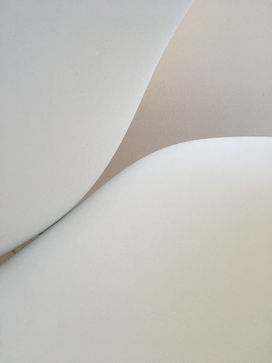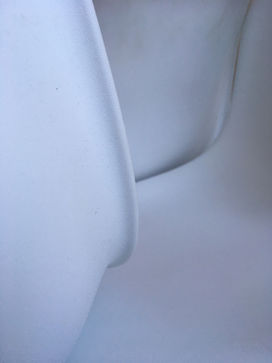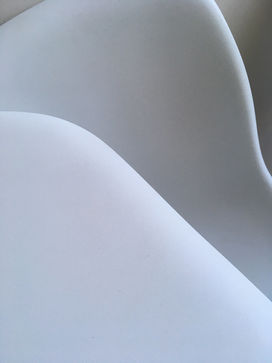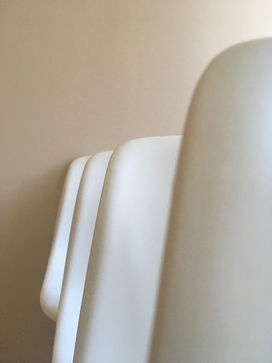commuting on eames
lisa rohrer
In Gaston Bachelard’s ethereal text The Poetics of Space, he locates the home as a container—an object that “shelters daydreaming, … protects the dreamer”, and enables us to collect localized memories through forming habits associated with the intimate space of the home (Bachelard 2014, 28). His oneiric exploration of space, intimacy, and memory encourages the reader to consider how “the house … in which we were alone, furnished the framework for an interminable dream, one that poetry alone, through the creation of a poetic work, could succeed in achieving completely” (Bachelard 2014, 37). It is through this poetic lens that I have surveyed the topography of my own home.
The daydream acts as a commuter landscape—a plane upon which I can move here and there, up and down, back and forth, without physically leaving a single site. Such a landscape is discussed often today. As I write this work, the world is experiencing the COVID-19 pandemic which has reorganised our contemporary models for moving to and from work. The modern
separation of home and work had already experienced a disruption from the 21st century “paradigm shift” of media convergence (Jenkins 2006, 5). The terminology of convergence is often employed to describe a movement from multiple media to a single medium—an all-in-one “black box” that enables users to play, work, read, and be entertained by accessing just one tool. However, as Jenkins points out, this definition limits convergence solely to a question of technology. In reality, we continue to use many of these “black boxes” which are individually converging but still work separately from one another to “suit your needs for accessing content depending on … your situated context” (Jenkins 2006, 15).
In the year 2020, I reflect on my personal commuting habits—a history of driving, public transport, cycling, and walking—all of which have provided me an in-between space among the space I call “home” and the space I call “work”. Commuting provides an in-between plane upon which I do not fall into one fixed category. Rather than acting as a liminal space that is “other” from work and home, commuting space acts as a container in which all other spheres, be they home or work or leisure, converge. De Certeau clarifies this distinction in his discussion of frontiers versus bridges by referring to Morgenstern’s zwischenraum poem: “The theoretical and practical problem of the frontier: to whom does it belong? … Passing by, an architect suddenly appropriates this ‘in-between space’ and builds a great edifice on it … Transformation of the void into a plenitude, of the in-between into an established place” (de Certeau 1980, 127). This bridge-building, so to speak, echoes what tourism scholars Minca and Oakes emphasize when they say that “despite the assumption or even hope that we might escape place to become ‘strangers’ …, place travels along with us—it is never left behind” (2006, 19). And yet, just as Jenkins confronts the black box theory as something of a fallacy, we also have not abandoned all other chairs in our homes or office spaces in favor of the subway seat. Instead, in this heightened season of convergence, we assign new values to these alternative seats—either turning them into sites of extreme convergence (by writing emails and talking on the phone whilst sitting on our toilets) or setting them apart as sacred spaces (for example, refusing to bring our work computers into our beds).
With these ideas in mind, I suggest that the act of commuting is the bridge that is built at the frontier of the workplace and the homeplace. When the physical site of the commute is no longer available to us, due to the reordering of remote work during the present pandemic, how do we reincarnate such memories of movement into activities unbound by physical space? The former commuting landscapes in which the subway seat (or car seat, bicycle saddle, etc.) acts as both a real and symbolic poly-functional space now describe our work-from-home spaces and, quite possibly, the entire physical space of our homes as we re-make them into environments that serve all realms of life.
What does it mean to understand the commute not as the separation of “home” and “work” but as a period that combines notions of home and work? When we consider the chairs we sit in to conduct specific activities (be it working, dining, resting, reading, producing, etc.) we have, since the 20th century, created boundaries: the home chair in which we lounge and the work chair in which we produce. Such boundaries construct frontiers which require a physical transference in order to escape the one and join the other. The subway seat is the convergence of these seemingly oppositional frontiers because it is a seat in which both, as well as many other, things occur. With this in mind, we can consider every seat in our home during COVID-19 as a commuter seat in which ideas of rest and work are intertwined.
Commuting on Eames is a collection of poetry that emphasizes the practice of the commute as an oneiric space—a dream landscape—in order to complicate the home/work dichotomy. The chair is not merely the theme, motif, or setting for these stories; rather, it is the story itself. It is not only the object of affection or frustration, but the embodiment of the introduction, climax, and conclusion of the narrative. In doing so, each sonnet emphasizes “sitting” as an imaginatively-physical action by which an individual poetically oscillates from one realm to another, only to find herself in the same physical space a moment later. As these sonnets are my own, the plane I find beneath me time after time is the bowled frame of a white, plastic Eames sidechair, whose advertising so perfectly describes itself as “a simple, gracious form that fits any body and every place” (hermanmiller.com).
As Kingwell has described: “Furniture structures space, making what is otherwise undifferentiated into something meaningful. I place a couch in an empty room and it acquires a new significance: the air now shimmers with the possibilities of conversation or napping or seduction” (Kingwell 2006, 177). If this is the case, then we must return once more to the place of the home, that intimate structure that “shelters daydream[s]”. As a collection, these sonnets reveal how the dwelling place does not merely mold into a site where one works from home. More profoundly, during this unique season we ask our homes to act as the settings of creative and imaginative stories—ones in which a simple plastic chair can transform into a throne, a reading nook, and a bed for dreaming.
poetry collection

References
Bachelard, Gaston. 2014 [1958] The Poetics of Space. New York: Penguin Group.
de Certeau, Michel. 2002 [1984] “Spatial Stories” in The Practice of Everyday Life. Translated by Steven Rendall. University of California Press. 115–130.
“Eames Molded Plastic Chairs.” Retrieved 15 May 2020.
Jenkins, Henry. 2006. Convergence Culture: Where Old and New Media Collide. NYU Press
Kingwell, Mark. 2006 [2002]. “Tables, Chairs, and Other Machines for Thinking” in Intimus, edited by Mark Taylor and Julieanna Preston. West Sussex.








